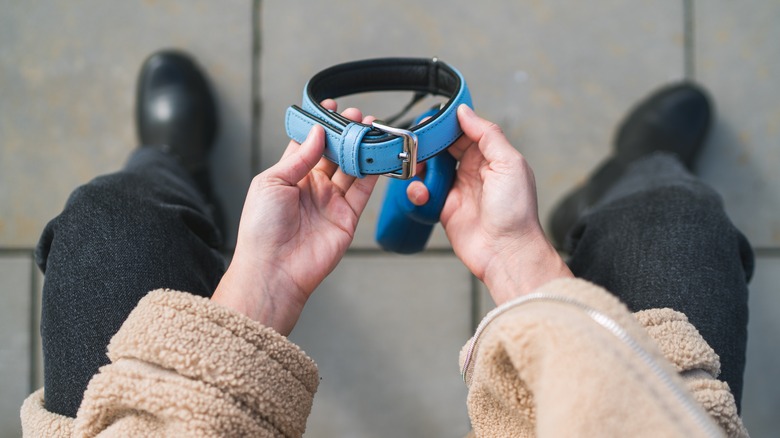How 'Transitional Objects' Can Help You Process Grief
When a special person in your life dies, it's perfectly natural to feel immense grief. Grief is complex; it looks and feels different to everyone (via Empathy). Grief is also a journey with many bends and detours. There are no shortcuts or deadlines for when this process will — if ever — come to an end. Instead, the effects of this loss will forever change your life. You too have transitioned into a new phase, and finding your footing can take some time.
Humans do a number of things to celebrate the memory of friends, family, and pets. We erect memorial sites, host annual commemorations, and participate in specific activities because it allows us to maintain our emotional relationship with our loved ones, even through death, as InStyle reported. We also find a connection to the departed in the intimate objects they leave behind — clothing, jewelry, toys, etc. That's a natural instinct, grief counselor Alan Wolfelt told InStyle. "We miss someone, so we reach for the closest alternative." If you're experiencing grief, transitional objects can help support you through this difficult time.
Transitional objects connect you to the loved one you lost
According to experts, transitional objects can help facilitate healthy grieving by keeping you "connected and feeling closer to the person you lost — and, in all honesty, helping [you] transition to living without them," social worker Cara Mearns-Thompson told InStyle. Also called transitional objects of grief or linking objects, Mearns-Thompson added that these everyday items provide a sense of security because you can carry your loved one with you figuratively — and literally. "Linking objects are tangible," added grief counselor Alan Wolfelt, "In addition to missing their body, their face, their smile, we miss their voice, their laughter, their scent, their touch." That's why transitional objects hold the power to make that person feel present in your life once again.
Our nostalgic attachments to objects like photos and teapots that we associate with our loved ones are more than just stuff. They're "sacred keepsakes" that return us to "a place and time of great solace and memory," noted family therapist Mark Brenner (via Psychology Today). Having a physical item that belonged to your loved one allows you to bring them with you into the new normal. As you continue on your grief journey, you can begin to develop "a new relationship with the deceased which can happen through these transitional objects as well as sustaining a loving connection with that person who died," added Mearns-Thompson, per InStyle.
Transitional objects let you tell your story
Beyond serving as a physical reminder of the departed, transitional objects can invite a conversation that allows you to share your loved one's name and history with other people, keeping their memory alive in your heart (via InStyle). Marketing executive Laura Madaio, who lost her father in 2018, told InStyle that regularly wears his clothes and loves it when people comment on her dad's now fashionably-chic distressed Western New England University sweatshirt. "It's always a little special for me when someone compliments me on something I'm wearing, and I get to say 'Thank you! It's my Dad's.'" She added, "Maybe, subconsciously, I hope people do ask."
"When we share a story about another, we invite them back into life," Robert Neimeyer, director of the Portland Institute for Loss and Transition, told InStyle. "We renew their membership in the club of life. We 'remember' them in this way." Transitional objects "provide the opportunity to speak the loved ones' name, to tell a bit of their story once more . . . These are perfectly normal, touching, interesting ways that we remind ourselves and others that our lives had significance because of these relationships." In telling others the story of our dearly departed, Neimeyer says, "we carry these people forward in our lives."
What happens when the transitional object also meets its end
As time passes, you may feel less drawn to your loved one's things — an indication, Alan Wolfelt told InStyle, that you are healing. But you may also keep the items close for many years, notes Robert Neimeyer. "I don't see any problem in people wearing their mother's engagement ring or something for the rest of their lives or having a special broach that represents their grandmother or keeping their dad's carved decoy on the library shelf," he said (via InStyle). However, some items — like clothing or cars — may eventually outwear their usefulness, and letting go can be challenging. After all, these objects provide security, and without them, it's understandable to feel cut off from that source of comfort (via Psychology Today).
But no matter the state of the object, what remains are the memories, assured Cara Mearn-Thompson (via InStyle). The experts at Empathy recommend taking photos to create a new linking object that connects you with the memory associated with the original item. If you're the person in charge of handling the worldly effects of your special person, this same principle can help you apply an "emotional lens" to certain objects — as opposed to all of a person's belongings — in order to say goodbye to things that could be useful to someone else. In releasing a transitional object, you enter yet another phase of life, stronger and more resilient for having loved and grieved.



